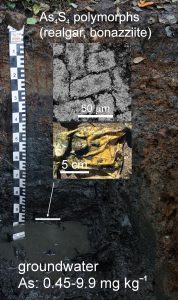 We used an in situ experimental technique with double nylon experimental bags to study the effect of low-cost organic materials (sawdust, wood cubes and hemp shives) on As sulfidation in three naturally As-enriched wetland soils. After 15 months of in situ incubation, all of the organic materials were covered by yellow-black mineral accumulations, dominantly composed of crystalline As4S4 polymorphs (realgar and bonazziite) and reactive Fe(II) sulfides (probably mackinawite). Our findings suggest an authigenic formation of AsS minerals in strongly reducing conditions of experimental bags by a combination of reduced exchange of solutes through the pores of the bag and comparatively fast microbial production of dissolved sulfide. Arsenic sulfide formation, as an effective treatment mechanism for natural and human-constructed wetlands, appears to be favored for As(III)-rich waters with a low Fe(II)/As(III) molar ratio, preventing the consumption of dissolved As and sulfide by their preferential incorporation into natural organic matter, and newly-formed Fe(II) sulfides, respectively.
We used an in situ experimental technique with double nylon experimental bags to study the effect of low-cost organic materials (sawdust, wood cubes and hemp shives) on As sulfidation in three naturally As-enriched wetland soils. After 15 months of in situ incubation, all of the organic materials were covered by yellow-black mineral accumulations, dominantly composed of crystalline As4S4 polymorphs (realgar and bonazziite) and reactive Fe(II) sulfides (probably mackinawite). Our findings suggest an authigenic formation of AsS minerals in strongly reducing conditions of experimental bags by a combination of reduced exchange of solutes through the pores of the bag and comparatively fast microbial production of dissolved sulfide. Arsenic sulfide formation, as an effective treatment mechanism for natural and human-constructed wetlands, appears to be favored for As(III)-rich waters with a low Fe(II)/As(III) molar ratio, preventing the consumption of dissolved As and sulfide by their preferential incorporation into natural organic matter, and newly-formed Fe(II) sulfides, respectively.
Peřestá, M., Drahota, P., Culka, A., Matoušek, T., Mihaljevič, M. (2022): Impact of organic matter on As sulfidation in wetlands: An in situ experiment. Science of the Total Environment 819, 152008. (DOI)





